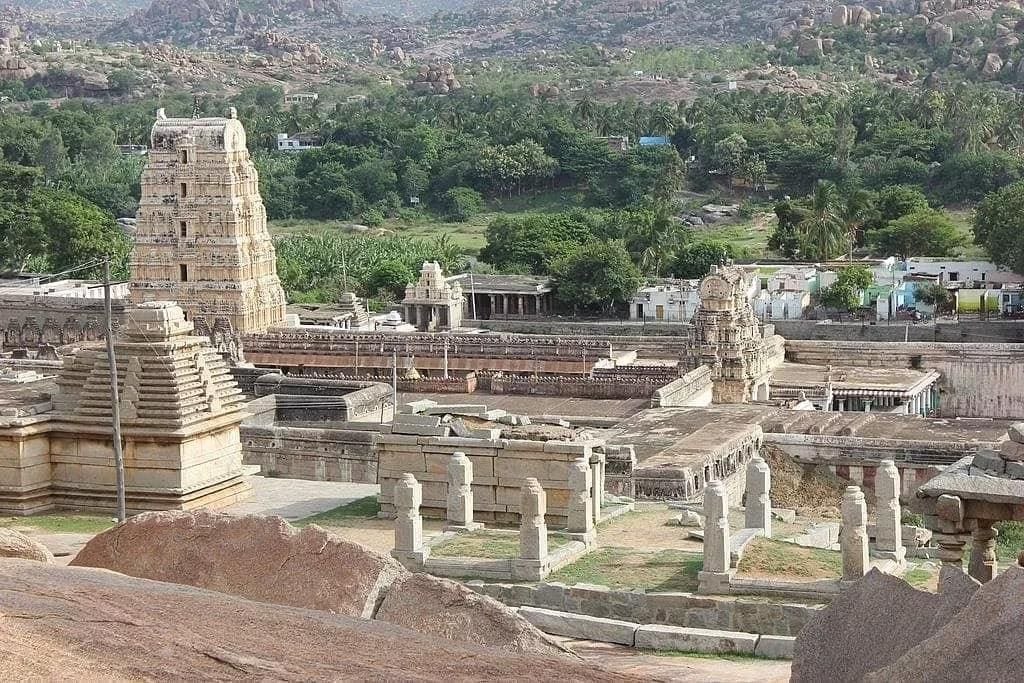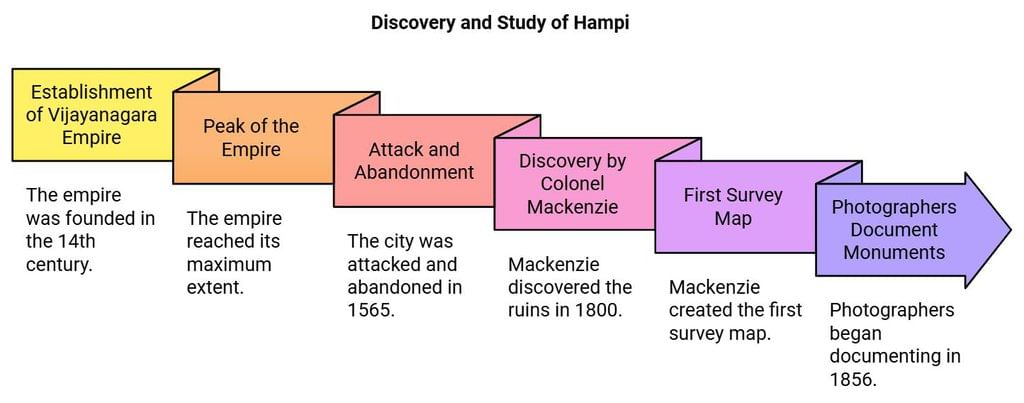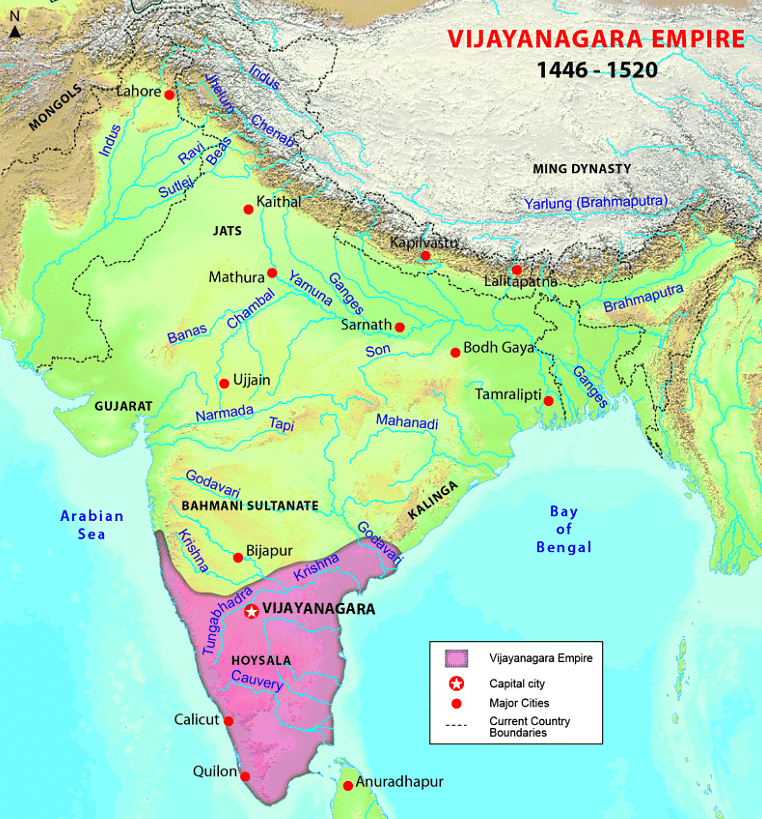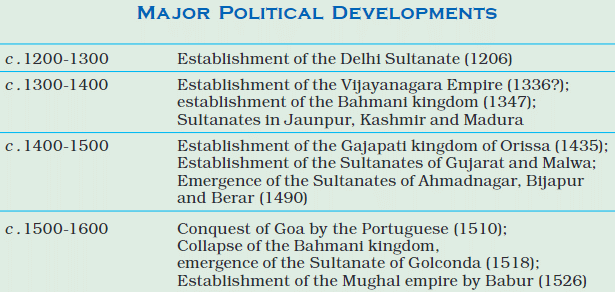An Imperial Capital Class 12 History
Introduction
Vijayanagara, also known as the "city of victory," was both a city and an empire. The empire was established in the 14th century. At its peak, the empire spanned from the river Krishna in the north to the southernmost part of the peninsula. In 1565, the city was attacked and subsequently abandoned. Despite falling into ruin in the 17th and 18th centuries, the memory of Vijayanagara lived on in the Krishna-Tungabhadra doab region. The locals referred to the city as Hampi, which was derived from the name of the local mother goddess, Pampadevi.
 Vijayanagara
Vijayanagara
The Discovery of Hampi
- The ruins at Hampi were discovered in 1800 by Colonel Colin Mackenzie, an engineer and antiquarian.
- Mackenzie prepared the first survey map of the site, based on information received from priests of the Virupaksha temple and the shrine of Pampadevi.
- Photographers began recording the monuments in 1856, allowing scholars to study them.
- Epigraphists started collecting inscriptions found at Hampi and other temples as early as 1836.
- Historians used these sources, along with accounts of foreign travelers and literature in Telugu, Kannada, Tamil, and Sanskrit, to reconstruct the history of the city and the empire.

Rayas, Nayakas and Sultans
- Two brothers named Harihara and Bukkafounded the Vijayanagara Empire in 1336.
- This empire included people who spoke different languages and followed different religious traditions.
- The Vijayanagara kings competed with other rulers for control of fertile river valleys and resources generated by overseas trade.
- Interaction with other states led to the sharing of ideas, particularly in architecture.
- The rulers of Vijayanagara borrowed concepts and building techniques and further developed them.
- The empire incorporated areas that had previously been powerful states, such as the Cholas in Tamil Nadu and the Hoysalas in Karnataka.
- The rulers of Vijayanagara, known as rayas, built upon these traditions and took them to new heights.
Kings and Traders
- The import of horses from Arabia and Central Asia was crucial for warfare during this time.
- Arab traders initially controlled this trade, but local communities of merchants, known as kudirai chettis or horse merchants, were also involved.
- In 1498, the Portuguese arrived on the west coast of the subcontinent and tried to establish trading and military stations.
- The Portuguese had superior military power, particularly their use of muskets, which made them important players in the politics of the period.
- Vijayanagara was known for its markets dealing in spices, textiles, and precious stones.
- Trade was seen as a status symbol for cities like Vijayanagara, which had a wealthy population that demanded high-value exotic goods, especially precious stones and jewelry.
- The revenue generated from trade significantly contributed to the prosperity of the state.
The Apogee and Decline of the Empire
- The polity of Vijayanagara had multiple claimants to power, including members of the ruling lineage and military commanders.
- The Sangama dynasty, the first dynasty of Vijayanagara, ruled until 1485.
- They were succeeded by the Saluvas, military commanders, who remained in power until 1503.
- The Tuluvas then took over and Krishnadeva Raya belonged to the Tuluva dynasty.
- Krishnadeva Raya's rule was characterized by expansion and consolidation of the empire.
- He acquired the land between the Tungabhadra and Krishna rivers and subdued the rulers of Orissa.
- Krishnadeva Raya also inflicted severe defeats on the Sultan of Bijapur.
 Krishnadeva
Krishnadeva
- The empire flourished under his rule, experiencing peace and prosperity.
- Krishnadeva Raya built temples and added impressive gopurams to south Indian temples.
- He founded Nagalapuram, a suburban township near Vijayanagara.
- After Krishnadeva Raya's death in 1529, strain began to show within the imperial structure.
- Rebellious nayakas or military chiefs troubled his successors.
- Control shifted to the Aravidu dynasty in 1542, which ruled until the end of the seventeenth century.
- Shifting alliances between Vijayanagara and the Deccan Sultanates resulted in tensions.
- An alliance of the Sultanates led to the defeat of Vijayanagara in 1565 at the Battle of Talikota.
- The city of Vijayanagara was sacked and abandoned within a few years.
- The focus of the empire shifted to the Aravidu dynasty ruling from Penukonda and later Chandragiri.
- Relations between the Sultans and the ragas (kings) were not always hostile, despite religious differences.
- Krishnadeva Raya supported some claimants to power in the Sultanates and had a title of "establisher of the Yavana kingdom."
- The Sultan of Bijapur intervened in succession disputes in Vijayanagara.
- The adventurous policy of Rama Raya, the chief minister of Vijayanagara, led to the Sultans combining against him and defeating him.
The rayas and the nayakas
- The Vijayanagara Empire had military chiefs called nayakas who controlled forts and had armed supporters.
- These nayakas often moved from one area to another, accompanied by peasants looking for fertile land.
- They spoke Telugu or Kannada and sometimes rebelled against the authority of the kings of Vijayanagara.
- The amara-nayaka system was a political innovation of the empire, likely influenced by the iqta system of the Delhi Sultanate.
- Amara-nayakas were military commanders given territories to govern by the king.
- They collected taxes and dues from peasants, craftspersons, and traders in their areas.
- They kept a portion of the revenue for personal use and to maintain a contingent of horses and elephants.
- These contingents served as an effective fighting force for the Vijayanagara kings.
- The amara-nayakas sent tribute to the king annually and showed loyalty by presenting gifts in the royal court.
- Kings occasionally transferrednayakas from one place to another to assert control.
- However, in the seventeenth century, many nayakas established independent kingdoms, leading to the collapse of the central imperial structure.
Vijayanagara – The Capital and its Environs
Vijayanagara, was characterised by a distinctive physical layout and building style:
Water Resources
- The location of Vijayanagara is characterized by a natural basin formed by the river Tungabhadra, which flows in a north-easterly direction.

- The city is surrounded by stunning granite hills that create a girdle-like formation around it.
- Numerous streams flow down from these rocky outcrops to the river, and embankments were built along these streams to create reservoirs of different sizes.
- Due to the arid climate of the region, elaborate arrangements were made to store rainwater and channel it to the city.
- The Kamalapuram tank, built in the early fifteenth century, was the most important reservoir and provided irrigation for nearby fields and the royal center.
- The Hiriya canal, built by the kings of the Sangama dynasty, drew water from a dam across the Tungabhadra and irrigated the cultivated valley that separated the sacred center from the urban core.
- The ruins of Vijayanagara also showcase the prominence of waterworks, with the Hiriya canal being one of the most prominent examples. This canal, built by the Sangama dynasty kings, channeled water from a dam on the Tungabhadra River to irrigate the valley between the “sacred center” and the “urban core”.
Fortifications and roads
- The city was enclosed by seven lines of fortifications, including walls and bastions.
- The outermost wall connected to the surrounding hills.
- The walls were built with wedge-shaped stones that fit together, with the inside filled with earth and rubble.
- The fortifications enclosed the city, along with its farmland and forests.
- Archaeological evidence shows there were farmlands within the walls. This was important to protect crops from sieges aimed at starving the defenders.
- Instead of building large granaries, the rulers of Vijayanagara included farmlands within the fortifications.
- The fortified area also had an inner city and a separate royal center, each with its own high walls.
- Well-guarded gates connected the fort to major roads.
- The gateways had arches and domes influenced by the Indo-Islamic style from the Turkish Sultans.
- Roads inside and outside the city were identified by gateways and pavement remains.
- Some of the important roads extended from temple gateways and were lined with bazaars.
The urban core
- Archaeological evidence of the houses of ordinary people in the urban core is scarce.
- Fine Chinese porcelain has been found in some areas, suggesting that these areas may have been occupied by wealthy traders.
- There was a Muslim residential quarter in the urban core, characterized by distinctive tombs and mosques.
- The architecture of the tombs and mosques in the Muslim quarter resembles that of the mandapas found in the temples of Hampi.
- According to the sixteenth-century Portuguese traveler Barbosa, the houses of ordinary people were thatched but well built and arranged according to occupations.
- The area was filled with shrines and small temples, indicating the prevalence of various cults supported by different communities.
- Wells, rainwater tanks, and temple tanks likely served as sources of water for the ordinary town dwellers.
The Royal Center
The royal center was situated in the south-western part of the settlement. Despite being called a royal centre, it consisted of more than 60 temples.- The rulers believed that patronizing temples and cults was important to establish and legitimize their authority.
- Around 30 building complexes were identified as palaces, which were larger structures not associated with rituals. Unlike temples, the secular buildings were constructed using perishable materials instead of masonry.
The mahanavami dibba
- The area has unique structures that have been named based on their form and function.
- The "king's palace" is the largest enclosure but there is no definite evidence that it was a royal residence.
- It contains two impressive platforms, known as the "audience hall" and the "mahanavami dibba".
- The complex is surrounded by high double walls with a street between them.
- The audience hall is a high platform with slots for wooden pillars and a staircase leading to the second floor.
- The purpose of the hall is unclear due to the closely spaced pillars.
- The "mahanavami dibba" is a massive platform on a high point in the city.
- It supported a wooden structure and is covered with relief carvings.
- Rituals associated with the structure likely took place during the Hindu festival of Mahanavami in September and October.
- The Vijayanagara kings demonstrated their power and prestige during these ceremonies.
- The rituals included worship, horse worship, animal sacrifice, dances, wrestling matches, and processions.
- The space surrounding the "mahanavami dibba" may not have been sufficient for large processions.
- The purpose of the structure remains a mystery.
Other buildings in the royal center
- The Lotus Mahal in the royal center of Vijayanagara was named by British travelers in the 19th century.
- Historians are unsure about the exact purpose of the Lotus Mahal, but one suggestion is that it may have been a council chamber or a place for the king to meet his advisers.
 Lotus Mahal
Lotus Mahal
- The Hazara Rama temple, also located in the royal center, was likely meant for the exclusive use of the king and his family.
- The central shrine of the Hazara Rama temple is missing its images, but there are sculpted panels on the walls depicting scenes from the Ramayana.
- Many structures in Vijayanagara were destroyed when the city was sacked, but the tradition of building palatial structures continued under the nayakas.
- Several of these palatial buildings have survived to this day.
The Sacred Centre
Choosing a Capital
- The northern end of the city is rocky and located on the banks of the Tungabhadra river.
- Local tradition believes that these hills were the monkey kingdom of Vali and Sugriva mentioned in the Ramayana.
- Another tradition suggests that Pampadevi, the local mother goddess, did penance in these hills to marry Virupaksha, the guardian deity of the kingdom.
- The marriage between Pampadevi and Virupaksha is celebrated annually in the Virupaksha temple.
- Jaina temples from the pre-Vijayanagara period can also be found in this area.
- Temple building in the region has a long history, dating back to dynasties such as the Pallavas, Chalukyas, Hoysalas, and Cholas.
- Rulers often encouraged temple building to associate themselves with the divine and to gain support and recognition.
- Temples also served as centers of learning and were important religious, social, cultural, and economic centers.
- The choice of Vijayanagara as the site for the kingdom may have been inspired by the shrines of Virupaksha and Pampadevi.
- The Vijayanagara kings claimed to rule on behalf of the god Virupaksha and signed all royal orders as "Shri Virupaksha".
- The rulers also used the title "Hindu Suratrana", which was a Sanskritisation of the Arabic term Sultan, meaning king.
- The rulers of Vijayanagara innovated and developed earlier traditions, such as displaying royal portrait sculptures in temples and treating the king's visits to temples as important state occasions.
Gopurams and Mandapas
- During this period, temple architecture showcased new features.
- One notable feature was the construction of large-scale structures, such as the raya gopurams or royal gateways, which were often bigger than the central shrines and symbolized imperial authority.
- These grand gateways were meant to signify the power of kings and their ability to command the necessary resources and skills for their construction.
- Other distinctive features included mandapas or pavilions and long, pillared corridors that surrounded the shrines within the temple complex.
- The Virupaksha temple, built over centuries, saw significant enlargement during the Vijayanagara Empire.
- Krishnadeva Raya, a ruler of the empire, constructed a hall and an eastern gopuram in the temple.
- The temple complex had various halls used for different purposes, such as hosting special performances or celebrating deity marriages.
- The Vitthala temple, dedicated to the deity Vitthala, was interesting as it introduced a form of worship from Maharashtra into Karnataka.
- The temple complex also featured chariot streets that extended from the temple gopuram, lined with pillared pavilions where merchants set up shops.
- Local nayakas, who ruled the region, continued and enhanced the traditional temple building practices, including the construction of remarkable gopurams.
Plotting Palaces, Temples and Bazaars
- A wealth of information on Vijayanagara, including photographs, plans, and elevations of structures and sculptures, was produced through surveys, travellers' accounts, and inscriptions.
- The site was preserved by the Archaeological Survey of India (ASI) and the Karnataka Department of Archaeology and Museums.
- In 1976, Hampi was recognized as a site of national importance.
- In the early 1980s, an important project was launched to document the material remains at Vijayanagara in detail, involving extensive and intensive surveys and a variety of recording techniques.
- Dozens of scholars from all over the world worked over nearly twenty years to compile and preserve this information.
- Mapping was a significant part of this project, involving dividing the entire area into squares and further subdividing them into smaller units.
- The detailed surveys have recovered and documented traces of thousands of structures, including shrines, residences, temples, roads, paths, and bazaars.
- Pillar bases and platforms have helped locate the remains of thriving markets.
- Wooden structures have been lost over time, but descriptions left by travellers have allowed for some reconstruction of the vibrant life during the Vijayanagara period.
Questions in Search of Answers
- Buildings provide insight into the organization and use of spaces, as well as the construction techniques and materials used.
- Fortifications can reveal information about defense requirements and military preparedness of a city.
- Comparing buildings in different places can help identify the spread of ideas and cultural influences.
- Buildings convey ideas and often contain symbols that reflect their cultural context.
- Understanding these symbols may require combining information from various sources such as literature, inscriptions, and popular traditions.
- However, architectural investigations do not provide information about the thoughts and perspectives of ordinary individuals who lived in or around these buildings.
- It is unclear whether ordinary people had access to areas within royal or sacred centers, or how they perceived and interacted with the impressive buildings.
- The opinions and thoughts of the workers who contributed their labor to these construction projects are also unknown.
Timeline

Conclusion
The Vijayanagara Empire remains a significant chapter in Indian history, known for its cultural heritage, architectural achievements, and contributions to trade. Despite its decline after the Battle of Talikota in 1565, the legacy of Vijayanagara endures through the ruins at Hampi. The empire's innovative administration and cultural blend highlight its importance as a medieval power and cultural hub, with ongoing preservation efforts keeping its memory alive.
|
30 videos|274 docs|25 tests
|
FAQs on An Imperial Capital Class 12 History
| 1. What were the key factors that led to the discovery of Hampi? |  |
| 2. Who were the Rayas, Nayakas, and Sultans, and what roles did they play in Hampi's history? |  |
| 3. What are the notable features of the Royal Centre and the Sacred Centre in Hampi? |  |
| 4. How were palaces, temples, and bazaars plotted and organized in Hampi? |  |
| 5. What questions remain unanswered about Hampi's historical significance? |  |

















